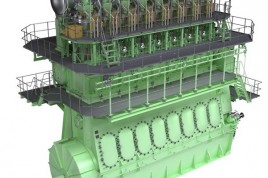MAN B&W’s Dual Fuel Marine Engine : A General Overview
Today the maritime industry is on the verge of a major change, from conventional methods of propulsion to modern and more economical and environment friendly methods.
In order to reduce fuel consumption in ships such as gas carriers, MAN B&W’s duel fuel or bi fuel ME- GI engines works both on conventional marine fuels and also on gas fuels.
Gas carrier cargo tanks are specially built, designed, and insulated to carry the liquefied cargo at a temperature as low as -161 °C. However, 0.1 to 0.17% of the total cargo boil off per day which is a natural phenomenon. This means if a ship is carrying total cargo of 20000 m3 in a voyage of 10 days, then the cargo that will boil off will be approximately 300000 liters.
This waste gas is used in the main propulsion engines of the ship, which reduces the overall fuel consumption of the ship, saving huge amount of money.
Construction of MAN B&W’s duel fuel ME- GI engines
ME-GI engines are designed to burn very low temperature gas cargo. As they handle gas as fuel, following safety features and equipments are used;
Conventional or Pilot Fuel Injection System:
The conventional fuel injection system is similar to that found in other MAN – 2 stroke engine.
Two fuel valves are provided on top of cylinder head, supplied via high pressure pipes from fuel pumps.
Gas Injection System:
Two gas injection valves are provided on top of the cylinder head along with two fuel injection valves.
The gas supplied is through double walled, jacketed pipe made of suitable material like stainless steel to withstand the low temperature if there is a gas leak.
Electronic Gas Injection Control (ELGI):
ELGI controls the gas injection in the cylinder by controlling the opening and closing of the gas injector valve.
Fuel Injection Valve Actuator (FIVA):
The FIVA valve controls the fuel oil quantity when the engine is used on both the fuels.
Different Modes of operation
The Duel fuel engines are always started in conventional diesel fuel oil. The ME GI engine can be operated in three basic modes-
1) Only gas mode- Constant gas injection when enough and constant gas supply is available, with fuel oil quantity for injection depends upon engine load.
2) Fuel and Gas mode-Both oil and gas fuel is used in the cylinder liner with oil fuel about 6 to 8 % depending upon the load of the engine.
3) Only fuel mode- When maneuvering or when no gas fuel is available, the engine is run on conventional fuel system.
Safety Incorporated in the System:
- The space in the double jacketed gas injection is filled with air with an extraction providing 30 air changes per hour, which maintains inside pressure less than the engine room pressure to avoid leakage.
- Hydro carbon sensor is fitted in the jacketed space for leak sensing.
- The gas pipes are pressure tested at 1.5 times the working pressure.
- The outer shield of the double layer pipe is made of stainless steel material to withstand low temperature.
- Sealing oil is supplied in injector with pressure 20-25 bar above gas pressure to avoid leakage.
- An accumulator at valve block is provided in the gas line for shutting down the system at low pressure. If the injector is stuck in open position, the pressure within the accumulator will fall and the pressure sensor will shut down the gas system.
- An inert gas purging line connects to the gas injection line when the system is not in use.
- If there is a non combustion inside the cylinder due to fuel not injected or not burning, the gas system shut downs and inert gas fills the line.
Advantages of Duel Fuel Engine
- The boil off cargo can be utilized as a fuel for propulsion of ship, thus saving money and energy.
- No need of costly re-liquefaction plant.
- Fuel consumption of the ship reduces.
- It produces less air pollution.
You may also like to read-Understanding Nuclear Marine Propulsion
References: mandieselturbo
Image Credits: rivieramm, maritimepropulsion
Do you have info to share with us ? Suggest a correction

About Author
An ardent sailor and a techie, Anish Wankhede has voyaged on a number of ships as a marine engineer officer. He loves multitasking, networking, and troubleshooting. He is the one behind the unique creativity and aesthetics at Marine Insight.
Subscribe To Our Newsletters
By subscribing, you agree to our Privacy Policy and may receive occasional deal communications; you can unsubscribe anytime.




